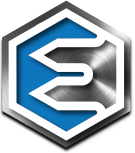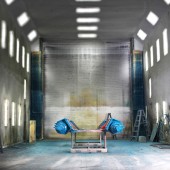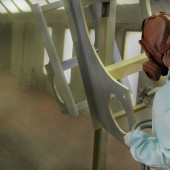ExacTech’s blast and paint processes are driven by the customer’s individual needs. Each job at ExacTech, from the fabrication to final stages, is designed to meet the customer’s exact specifications.
Prior to paint application, a blasting process takes place. The blasting of the steel uses abrasive and compressed air to remove and clean the surface of any previous paint coating, impurities and abrasive residue. At ExacTech, open air blasting uses compressed air and upper-end abrasive media are used to clean the surface of any potential paint residue, mill scale, corrosion or rust. Cleaning processes range from SSPC-SP6 to SSPC-SP10 standards, set by The Society for Protective Coatings (SSPC). SP6, or commercial blast cleaning, removes all rust, dirt, grease, oil, prior coating, and any other foreign material that is visible to the blaster. The SP6 cleaning process is based on a one-third to two-thirds ratio, where one-third of each square inch can have minimal streaks or stains. SP10 blasting requires a more in-depth clean blast, leaving only 5% of minor streaks and minimal discolorations visible while the remaining 95% are completely free of all other filtrates.
ExacTech’s skilled team of painters work at military and marine standards with two paint booths measuring 18’ x 55’ and 20’ x 50’10”. The two spray rooms can handle the most complex paint applications.
Current paint coatings being used at ExacTech –
- epoxy, zinc, waterborne primers
- urethane, enamels, alkyds, waterborne top coats
Airless and conventional sprayers are used at ExacTech in order to provide various paint spray options when tackling each individual task.
Airless paint sprayers pump paint at extremely high pressures. The paint is sent through a hose and through a tungsten carbide spray tip, in the paint spray gun, creating a broad, fan-shaped pattern of paint to be evenly distributed on the surface. There are many advantages of airless painting, such as a faster paint speed, consistent and high quality finish and the flexibility to paint on a wide range of materials. Larger, less complex surfaces are the best option for airless paint spray procedures.
The conventional spraying process allows for more precise finishes due to the ability to regulate and control output and air pressure. Conventional spraying, also known as pressure pot spraying, is best suited for detail-orientated projects.
Prior to blasting and painting, our painters make sure that ambient and surface temperatures are checked before beginning the process. ExacTech uses a dew point calculation chart to ensure that each blasting and coating application is performed under ideal environmental conditions. Dew point is measured to see if moisture will form on the service. If moisture is present, it can result in rust or residue to form on the surface. ExacTech measures dew point to work efficiently and avoid the need to backtrack and rework the blasting or paint process. After paint completion, product is inspected and dry mil readings are taken and recorded per paint manufacturer’s recommendations.
In addition to the painting and assembly processes, ExacTech offers a number of turnkey capabilities that continue to exceed customer expectations. ExacTech’s cost effective processing and precision machining ensure the highest quality while cutting down on project overhead and expediting the entire fabrication process.



